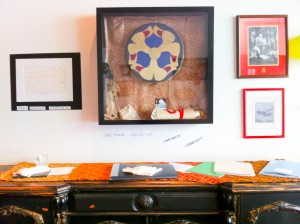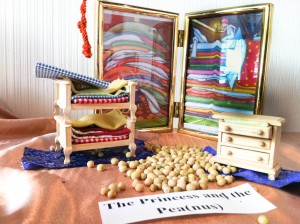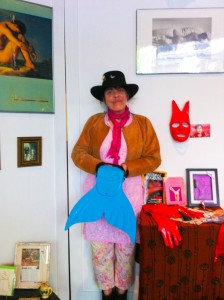Beneath the Veneer
By: D. L. Williams
Montana King’s The Thin Veneer of the Lost Limbic: Does the Male have a Psyche was last month’s exhibition at Atira’s Enterprising Women Making Art. Among the many issues explored, this exhibition questions what it is in both media, and more controversially, in the male psyche that tends towards violence and exploitation of women. Other issues she considers include erotica, suffering, addictions and mental health, the female form, trauma, and importantly the role of healing and transformation as symbolized for her through the whale.
“The subheading for the show is Transformations,” says King. “I started this research exploring drugs and the chains of humanity – trauma and violence. But this exhibition has moved onto transformations, which is where the whales come in. The unchained. They introduce the possibilities of healing.”
The show is dense, a smorgasbord of items both large and small spread across tables, hung on walls, and decorating shelves. The effect is of walking into a domestic setting, a kitchen or a living room, perhaps – but what first appears as decor, quickly reveals a startling candor about the violence and heartbreak that permeate many households. There are martini glasses with syringe-garnishes, picture frames with images of women objectified; miniature models retelling fairytales as scenes of sexual assault: The Princess and the Pea(nus). Opening any number of research books reveals titles and topics around sexuality and pornography. Yet, interspersed between these many disconcerting ‘household’ items is a display case featuring a handmade drum with the tales of whales painted on it and countless drawings and prints of whales.
King’s “shrine to love” is particularly captivating. On a podium against a wall an arrangement of red and white objects catch the eye. The installation is evocative of displays in drug-stores and shopping centers around Valentine’s Day. There is red nail polish, a National Geographic magazine covering ‘Love’, a red condom, red gloves, a negligee, some wrapping paper with red roses on it, a box of chocolates. All the red and glitz is reminiscent of hallmark interpretations of ‘love’. One can’t help but ask, “Why do elbow length feaux-leather gloves, or a red negligee suggest ‘love’?” One item, however, stands apart from the rest. There is a hand-carved penis pendant adjacent a poem nestled inside a picture frame. The poem establishes a jarring contradiction against the rest of the installation: “Go away, come back/what a relief of pain/When you hit me/With supposed nice words/Another I love you/In the mist.”
King’s exhibition gives pause for reflection. Rather than taking any one specific stance on the many issues she explores, her drawings, installations and research create juxtapositions: suffering alongside love, despair next to hope. These contrasts offer depictions of both realities and dreams. She challenges easy interpretations by creating an environment filled with paradox. What pulls together the various disparate and disturbing elements of the show is the overarching metaphor of the whale literalized through the many images, paintings, and prints woven throughout. The whale introduces an element of fluidity, movement and magnitude amidst issues that often leave one feeling resistant, stuck, and small. Ultimately, the show as a whole is an invitation: what transformation may be possible beneath the veneer of simplistic interpretations of either love and sexuality or violence and trauma?
For More Information on Montana King, visit: website
For More Information on Atira’s Enterprising Women Making Art, visit: website










